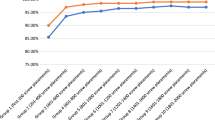Abstract
Suboptimal placements of pedicle screws may lead to neurological and vascular complications. Computer-assisted image guidance has been shown to improve accuracy in spinal instrumentation. Checking the accuracy of the navigation system during pedicle screw placement is fundamental. We describe a novel technique of using continuous accuracy check of the navigation system during O-arm-based neuronavigation to instrument the thoracolumbar region. Forty thoracic and 42 lumbar screws were inserted in 12 patients. The Mirza evaluation system was used to evaluate the accuracy of the inserted screws. There was no neurological injury and no need to reposition any screw. The accuracy of the screws placement was excellent. Our technique of continuous at will operational accuracy check of the neuronavigation system is associated with extreme accuracy of screw placement, no need to bring a patient back to the operating room to reposition a pedicle screw, and with excellent outcome.





Similar content being viewed by others
References
Amato V, Giannachi L, Irace C, Corona C (2010) Accuracy of pedicle screw placement in the lumbosacral spine using conventional technique: computed tomography postoperative assessment in 102 consecutive patients. J Neurosurg Spine 12(3):306–313. doi:10.3171/2009.9.SPINE09261
Beck M, Mittlmeier T, Gierer P, Harms C, Gradl G (2009) Benefit and accuracy of intraoperative 3D-imaging after pedicle screw placement: a prospective study in stabilizing thoracolumbar fractures. Eur Spine J 18(10):1469–1477. doi:10.1007/s00586-009-1050-5
Benzel EC, Rupp FW, McCormack BM, Baldwin NG, Anson JA, Adams MS (1995) A comparison of fluoroscopy and computed tomography-derived volumetric multiple exposure transmission holography for the guidance of lumbar pedicle screw insertion. Neurosurgery 37(4):711–716
Berry E, Cuppone M, Porada S, Millner PA, Rao A, Chiverton N, Seedhom BB (2005) Personalised image-based templates for intra-operative guidance. Proc Inst Mech Eng H 219(2):111–118
Bjarke Christensen F, Stender Hansen E, Laursen M, Thomsen K, Bunger CE (2002) Long-term functional outcome of pedicle screw instrumentation as a support for posterolateral spinal fusion: randomized clinical study with a 5-year follow-up. Spine (Phila Pa 1976) 27(12):1269–1277
Bledsoe JM, Fenton D, Fogelson JL, Nottmeier EW (2009) Accuracy of upper thoracic pedicle screw placement using three-dimensional image guidance. Spine J 9(10):817–821
Glossop ND, Hu RW, Randle JA (1996) Computer-aided pedicle screw placement using frameless stereotaxis. Spine (Phila Pa 1976) 21(17):2026–2034
Hart RA, Hansen BL, Shea M, Hsu F, Anderson GJ (2005) Pedicle screw placement in the thoracic spine: a comparison of image-guided and manual techniques in cadavers. Spine (Phila Pa 1976) 30(12):E326–E331
Kosmopoulos V, Schizas C (2007) Pedicle screw placement accuracy: a meta-analysis. Spine (Phila Pa 1976) 32(3):E111–E120. doi:10.1097/01.brs.0000254048.79024.8b
Mirza SK, Wiggins GC, Kuntz C, York JE, Bellabarba C, Knonodi MA, Chapman JR, Shaffrey CI (2003) Accuracy of thoracic vertebral body screw placement using standard fluoroscopy, fluoroscopic image guidance, and computed tomographic image guidance: a cadaver study. Spine (Phila Pa 1976) 28(4):402–413
Nottmeier EW, Seemer W, Young PM (2009) Placement of thoracolumbar pedicle screws using three-dimensional image guidance: experience in a large patient cohort. J Neurosurg Spine 10(1):33–39. doi:10.3171/2008
Park P, Foley KT, Cowan JA, Marca FL (2010) Minimally invasive pedicle screw fixation utilizing O-arm fluoroscopy with computer-assisted navigation: feasibility, technique, and preliminary results. Surg Neurol Int 1:44. doi:10.4103/2152-7806.68705
Rajasekaran S, Vidyadhara S, Ramesh P, Shetty AP (2007) Randomized clinical study to compare the accuracy of navigated and non-navigated thoracic pedicle screws in deformity correction surgeries. Spine (Phila Pa 1976) 32(2):E56–E64
Rampersaud YR, Lee KS (2007) Fluoroscopic computer-assisted pedicle screw placement through a mature fusion mass: an assessment of 24 consecutive cases with independent analysis of computed tomography and clinical data. Spine (Phila Pa 1976) 32(2):217–222
Schizas C, Michel J, Kosmopoulos V, Theumann N (2007) Computer tomography assessment of pedicle screw insertion in percutaneous posterior transpedicular stabilization. Eur Spine J 16(5):613–617
Schwender JD, Holly LT, Rouben DP, Foley KT (2005) Minimally invasive transforaminal lumbar interbody fusion (TLIF): technical feasibility and initial results. J Spinal Disord Tech 18(Suppl):S1–S6
Sugimoto Y, Ito Y, Tomioka M, Shimokawa T, Shiozaki Y, Mazaki T, Tanaka M (2010) Clinical accuracy of three-dimensional fluoroscopy (IsoC-3D)-assisted upper thoracic pedicle screw insertion. Acta Med Okayama 64(3):209–212
Tian NF, Xu HZ (2009) Image-guided pedicle screw insertion accuracy: a meta-analysis. Int Orthop 33(4):895–903. doi:10.1007/s00264-009-0792-3
Tormenti MJ, Kostov DB, Gardner PA, Kanter AS, Spiro RM, Okonkwo DO (2010) Intraoperative computed tomography image-guided navigation for posterior thoracolumbar spinal instrumentation in spinal deformity surgery. Neurosurg Focus 28(3):E11
Conflict of interest
None of the authors has any conflict of interest concerning the financial, materials, or methods used in this study or the findings specified in this paper.
Author information
Authors and Affiliations
Corresponding author
Additional information
Comments
Alexander Brawanski, Regensburg, Germany
The authors propose an interesting method to increase the accuracy of the placemant of pedicle screws. There are several other methods to increase accuracy, their’s is an interesting alternative.
Rights and permissions
About this article
Cite this article
Ammirati, M., Salma, A. Placement of thoracolumbar pedicle screws using O-arm-based navigation: technical note on controlling the operational accuracy of the navigation system. Neurosurg Rev 36, 157–162 (2013). https://doi.org/10.1007/s10143-012-0421-2
Received:
Revised:
Accepted:
Published:
Issue Date:
DOI: https://doi.org/10.1007/s10143-012-0421-2




